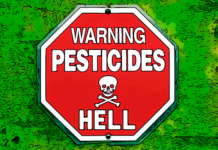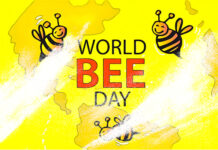Pesticides are the primary cause of the ongoing extermination of bees, butterflies and other pollinating insects. And European citizens are responding with the initiative ‘
Save the Bees
‘, registered by the European Commission on 15.5.19. Which will need to collect 1 million signatures in at least 7 member countries in the 12 months to follow. Here’s why.
Pesticides and bees, dangerous relationships
Colony Collapse Disorder (CDD)-a phenomenon involving loss of orientation in insect colonies, which are thus doomed to die-was first recorded in the U.S., where intensive agriculture makes extensive use of agrotoxics. The honey bee scourge, with losses ranging from 50 to 90 percent, was first attributed to a combination of factors. Pesticides, mites, fungi, and viruses. Scientific research has since identified a direct causal relationship between pollinating insects’ exposure to neonicotinoid pesticides and CDD. Bees, butterflies and many other species are not actually the main target of these substances, but they do affect their central nervous systems. Causing paralysis and loss of memory and orientation functions. As well as damage to reproduction and general weakening, with less ability to resist disease.
Neonicotinoids are a group of chemically synthesized substances whose structure is similar to nicotine. They exert a similar attraction to nicotine in humans, with effects 10,000 times more harmful to pollinators than other pesticides. They were introduced in the mid-1990s as alternatives to ‘classic’ agrotoxics – e.g., DDT, HCH – precisely because of their lower impact on the ecosystem. At least on the surface, until they too revealed the concrete effect of causing the extinction of those insect species on which the pollination of 3/4 of crops planet-wide depends.
TheEnvironment Protection Agency (EPA, USA) has also collected scientific evidence on the high toxicity to bees of several other groups of pesticides, including organophosphates and pyrethroids (also widely used to combat mosquitoes). However, without taking concrete action until May 2019, when 13 neonics were excluded from the Federal Register of insecticides allowed in agriculture. A outcome of negotiations with the Center for Food Safety, which had initiated legal action back in 2013 along with several NGOs and four beekeepers. Moreover, neonicotinoids account for about one-third of the pesticides sold on the planet to date. Where the world’s best-selling agrotoxic, glyphosate, has itself been shown to be dangerous (even) to apoids, whose microbiome it alters.
Neonicotinoids, risk assessment and restrictive measures
The European Food Safety Authority (EFSA), in February 2018, revised its previous assessments on three neonics (clothianidin, imidacloprid, and thiamethoxam). Affirming its concrete danger to the survival of bee populations. The European Union subsequently introduced a ban on their use in open fields-not also in greenhouses-as of 19.12.18.
France went further, extending the ban to all agricultural uses (including greenhouse crops) and two other neonicotinoids (thiacloprid and acetamiprid). Effective 1.9.18, subject to granting transitional waivers to individual operators, for acetamiprid only, until 1.7.20. In the context of a broader national program to phase down agrotoxics, starting with broad-spectrum ones (e.g., glyphosate). Based on the assessments made by the National Agencies for Food Safety (ANSES) and Agricultural Research. The latter of which showed that the drastic reduction in pesticide use is not matched by any real harm to agricultural productivity.
Italy, the value of bees and the theory of law
Law 313/04 ‘recognizes beekeeping as activities of national interest useful for the conservation of the natural environment, the ecosystem and agriculture in general and is aimed at ensuring the natural pollination and biodiversity of bee species, with particular reference to the preservation of the Italian bee breed (Apis mellifera ligustica Spinola) and the native bee populations typical of or in border areas‘. (1) For the specific purpose of ‘safeguarding the pronous action of bees, the regions (…) shall identify the limitations and prohibitions to which pesticide treatments with plant protection products and herbicides toxic to bees on tree, herbaceous, ornamental and wild crops during the flowering period shall be subjected, establishing the corresponding penalties‘. (2)
The use of ‘phytosanitary ‘ of sorts, during the flowering period of melliferous plants, thus incorporates an administrative penalty in Italy, subject to penalties that vary from one Region to another. Subject to
the occurrence of the crime of ‘killing or damaging animals of others,’ the prosecution of which is tied to the filing of a complaint by the offended person. (3) That is, that-in the most serious cases, which the prosecution has the not simple burden of proving-of environmental pollution. (4) From theory to practice, although the above standards receive little enforcement, the extent of the phenomenon can be observed. To share the need to introduce new rules.
Bee health, monitoring in Italy and Europe
BeeNet – a nationwide bee health monitoring program established by MiPAAFT’s Rural Network with contributions from various agencies (IZS delle Venezie, University of Bologna, CRA, Regions and ASLs)-has already amply demonstrated the impact of ‘tanned’ (i.e., pesticide-treated) seeds on bee colony depopulation. The environmental disaster is unraveled through the census that beekeepers help to carry out on the various territories. Locating, with a fair margin of accuracy, areas affected by agrotoxin misuse. By sowing ‘tanned’ seeds (i.e., treated with pesticides), disapplying the albeit mild ‘precautions’ indicated on the Big 4 bags, i.e., uncontrolled spraying.
The COLOSS(Prevention of honey bee COlony LOSSes) report, published on 5/30/19, was produced by the Swiss NGO of the same name to investigate the health of beekeeping. (5) Coloss is an international nonprofit project involving researchers from all over the planet with the goal of protecting beekeeping, bees, and consumers through targeted studies on various topics, from ‘beekeeping technique’ to the analysis of risks that threaten the industry (diseases, first and foremost). And product protection through adoption of quality and food safety standards to combat fraud on honey and honey products.
The researchers administered a questionnaire to 25,363 beekeepers in 33 in countries of the macro-region Europe, as well as in Algeria, Israel and Mexico. The largest overall losses in winter 2017/18 were in Portugal (-32.8%). Losses of more than 25 percent have affected beekeeping in Slovenia, Northern Ireland, England, Wales, Italy, Spain, and Germany. The European average is around 16 percent,
The disappearance of pollinating insects causes irreparable damage to the environment, both direct (honey production, biodiversity) and indirect. Because the balance of se natural food chains, involving birds and their predators, is disrupted. To put an end to this ecocide, the ‘Save The Bees’ initiative was launched, finally landing in Brussels after a major public mobilization.
‘Save The Bees,’ the European citizens’ initiative.
‘Save the Bees! Protecting Biodiversity and Improving Insect Habitats in Europe‘ is the European citizens’ initiative proposal registered by the Commission with effect from 27.5.19. (6) The premise is self-evident, ‘we need insects for our ecosystems and to ensure food security. Commission to adopt legislation to preserve and improve insect habitats as indicators of a pristine environment‘.
The objectives of the initiative are declined in the following terms:
– the European Union must recognize the seriousness of the problem and implement a policy that can effectively remedy it, which must include research activities and regulatory measures. In particular, one must
– ‘identify alternatives, including technological solutions to reduce pesticide use,
– Ban harmful pesticides without exception and reform eligibility criteria,
– Promote the structural diversity of agricultural landscapes,
– Effectively reduce fertilizers (e.g., Natura 2000 project),
– Effectively establish conservation areas (e.g. Water Framework Directive),
– intensify research and monitoring and improve education.”
The historical antinomy between the positions of the agricultural supply chain-systematically uninformed, indoctrinated and influenced by pesticide and seed monopolists-and those of beekeepers must be overcome. The latter of which inevitably coincide with those of citizens most sensitive to the present and even the near future of the ecosystem. For the survival of the planet and the well-being of its creatures is a value that cannot be betrayed in the name of the short-term material interests of individuals. And that is why we cited the example of urban beekeeping in its various forms — starting with simply maintaining ‘bee pastures’ — as an engine of social innovation.
The measures to be taken, after all, must be shared on the widest possible geographical scale. Because biodiversity expresses the riches of different ecosystems, which in turn communicate and interact, regardless of territorial boundaries. The recent discovery of the volatility of microplastics-capable of traveling thousands of miles to corrupt pristine areas and eventually returning to the body of humans who have placed a cause there-offers a concrete example of how to ‘do the right thing. Every day, starting with small daily gestures, ethical choices are needed from everyone.
#Ègalité!
Dario Dongo and Guido Cortese
Notes
(1) See Law 24.12.04 no. 313, ‘regulation of beekeeping,’ Article 1, at https://www.gazzettaufficiale.it/eli/id/2004/12/31/004G0346/sg
(2) See Law 313/04, Article 4.
(3) See Criminal Code, Article 638. ‘Whoever without necessity kills or renders unserviceable or otherwise deteriorates animals belonging to others shall be punished, unless the act constitutes a more serious crime, on complaint of the offended person, by imprisonment of up to one year or a fine of up to 309 euros‘
(4) Article 452-bis of the Criminal Code punishes with imprisonment for two to six years and a fine of 10,000 to 100,000 euros anyone who illegally causes significant and measurable impairment or deterioration:
– of water or air, or of large or significant portions of the soil or subsoil,
– Of an ecosystem, biodiversity, including agricultural biodiversity, flora or fauna
(5) Brodschneider, R., Gray, A., Adjlane, N., Ballis, A., Brusbardis, V., Charrière, J.-D. Danihlík et al. (2019). ‘Loss rates of honey bee colonies during winter 2017/18 in 36 countries participating in the COLOSS survey, including effects of forage sources‘. Journal of Apicultural Science. https://doi.org/10.1080/00218839.2019.1615661
(6) See Decision (EU) no. 2019/847, https://eur-lex.europa.eu/legal-content/IT/TXT/HTML/?uri=CELEX:32019D0847&from=IT








